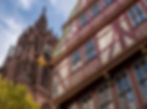
"In a city like Frankfurt, one finds oneself in a strange situation; the strangers who constantly pass one another point to all parts of the world and arouse the desire to travel", Goethe said in his autobiography entitled "Poetry and Truth".
Frankfurt, on the banks of the river Main, is indeed a real European crossroads, geographically, historically and economically.
The city of emperors
The name Frankfurt is first mentioned in a document from the end of the 8th century. It was then called Franconofurd, which meant "the ford of the Franks". Charlemagne himself built a palace here. As a result, Frankfurt soon became one of the largest cities in the Holy Roman Empire. From the middle of the 9th century onwards, German emperors were appointed here and then crowned in Aachen, which accelerated the city's development. It then became an imperial free city and in 1250 was granted new privileges.
The Collegiate Church of St. Bartholomew, often referred to as the Cathedral, is one of the witnesses to this Holy Roman Empire, which lasted for a thousand years. On a tour of Frankfurt, you will certainly come across this building, which was largely rebuilt in the 20th century after the bombing. Despite its modern appearance, the Gothic cloister, the transept and the monumental tower remain of the place where the emperors were crowned from 1562 until the fall of the Reich in 1806.

You will also discover the Römerberg square during your visit. Typical of the region, it surrounds the town hall - the Römer, with its sculptures of the German emperors and their symbolic eagle - and hosts many fairs, including the Christmas market.
A grüne Soße in the heart of Sachsenhausen?
In the 16th century, Frankfurt was the centre of artistic and commercial activities. Following the invention of the movable type printing press by Johannes Gutenberg in the region of Strasbourg, Frankfurt became the most important book fair in the Holy Roman Empire. The subsequent period of prosperity lasted only a century. The craftsmen's uprising at the beginning of the 17th century, followed by the plague epidemic, weakened the city's power.

Historic buildings remain from the Middle Ages and the Renaissance. In the district of Sachsenhausen, which you can walk through on one of our routes, there are still some traditional houses along the cobbled streets.
If you feel like it, take a break from sightseeing in Frankfurt and enjoy a glass of Apfelwein, the local cider, with potatoes covered in grüne Soße, a sauce imported by Johann Wolfgang von Goethe's grandfather when he immigrated to Frankfurt from Lyon! You might also like Frankfurters, the famous hot dog sausages, now popular all over the world.
The towers of "Mainhattan"
During the Second World War, Frankfurt was almost completely destroyed by Allied bombing. Particularly on 22 March 1944, when a British attack destroyed almost the entire historic centre, killing 1,001 people instantly. The city was rebuilt, sometimes identically, like the Römerberg. But often the choice was resolutely modern.
Despite the fact that in 1949, following the elections for the first German Bundestag, Bonn was chosen over Frankfurt as the capital of the FRG, the latter quickly became a leading financial centre. Today, Bonn is one of Germany's most important cities and its leading economic centre.
This development, and the subsequent economic wealth of the city, led to the rapid construction of large buildings in the banking district. Frankfurt is the seat of the European Central Bank.
If you run or walk through the centre of Frankfurt, you will see the twin towers of the Deutsche Bank, or the Stock Exchange, which is Germany's largest trading market. It handles 85% of German stock trading! In front of it stand the two famous statues of the bear and the bull. The first symbolises the fall in prices, and the second the rise.

Run with Runnin'City, from the collegiate church of St Bartholomew to the Frankfurt Stock Exchange!